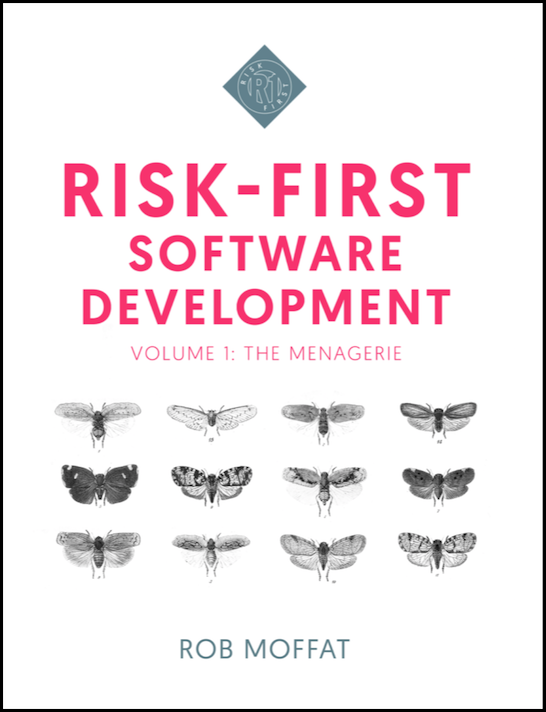Risk-First Analysis Framework
Start Here
Home
Contributing
Quick Summary
A Simple Scenario
The Risk Landscape
Discuss
Please star this project in GitHub to be invited to join the Risk First Organisation.
Publications

Click Here For Details

What Is It
Prioritisation is a key process in trying to focus on building useful stuff first. It could look like:
- A Sprint Planning Meeting: Deciding on the most important things for the team to build in a time period.
- Phased Delivery: Breaking a large project into smaller-scoped projects.
- A Backlog: Having tasks or stories in delivery order in a queue.
- Task Decomposition: Breaking down larger units of a task into smaller items. Often, Requirements come bundled together and need to be broken down so that we work on just the most vital parts, as in
- Identifying the MVP: Trying to cast out all non-essential functionality.
Prioritisation relies on not delivering all the functionality in one go. But it tends to be a spectrum:
- Big Bang: Delivering all the functionality in a single go.
- Cycles, or Phases: Splitting a large project into smaller chunks.
- Sprints: Delivering with a fixed cadence, e.g. every month or week.
- Continuous Delivery: Delivering functionality one-piece-at-a-time.
Usually, risk is mitigated by Prioritisation. But sometimes, it’s not appropriate: When Finland changed from driving on the right side of the road to the left, (in order to be in line with the rest of Europe) the changeover had to be Big Bang and the whole country changed overnight.
How It Works
There are several ways you can prioritise work:
- Largest Mitigation First: What’s the thing we can do right now to reduce our Attendant Risk most? This is sometimes hard to quantify, given Hidden Risk, so maybe an easier metric is…
- Biggest Win: What’s the best thing we can do right now to reduce Attendant Risk for least additional Schedule-Risk? (i.e. simply considering how much work is likely to be involved)
- Dependency Order: Sometimes, you can’t build Feature A until Feature B is complete. Prioritisation helps to identify and mitigate Dependency Risk.
By prioritising, you get to Meet Reality sooner and more frequently and in small chunks.
Feedback Loops & Risks Mitigated
Review
This one way in which a particular prioritisation Meets Reality
- Developers might tell you that the ordering incurs Dependency Risk or Coordination Risk if everyone is going to end up working on the same components.
- Product Owners might tell you that you’re not tackling the right Feature Risk.
- If you’re trying to work out what the MVP is, prioritisation might help your investors determine whether the project is worth funding.
Production Risk
Breaking a large delivery down into lots of small releases has an impact on Production Risk:
- Usually, lots of small releases allows you to practice the release process while the project is relatively unimportant. This experience allows you to figure out automation and reduce the Process Risk of releasing too.
- Smaller, higher-cadence releases also reduce Visibility Risk, because users don’t have large amounts of change to get accustomed to all-in-one-go.
Schedule Risk
If you’re able to do Continuous Delivery, and have de-risked the release process, then you can eliminate some Schedule Risk, because you’ll know you can hit any date with something. The risks of what you deliver on that date are then Feature Risk rather than Schedule Risk.
Attendant Risks
Dependency Risk
The biggest risk to phased delivery is that you try and build functionality now that actually relies on things scheduled to be built later.
Schedule Risk
Sometimes, releases have a cost associated with them in terms of time and bureaucracy to perform them. Obviously, then, the more releases you’ll do, the less time you’ll spend doing other stuff, like building functionality. The trick to doing frequent releases is therefore to ensure they are low cost, and this means automation. But, building automation adds schedule risk too.
Complexity Risk
If you are replacing an old system with a new one, incrementally replacing functionality is a good way to go when the system is complex. However, this means that you’re going to have two systems running at the same time, which is inevitably more complex than just one system.
PLanning
- also gannt chart
- critical path
- roadmap
- dependency analysis
Discuss the tool Duncan and I used to determine whether a release date was feasible.
- planning using risk
https://en.wikipedia.org/wiki/Planning_fallacy
– estimating: holding the risks in your hand and saying, which is heavier?
Risk-First planning: break down the goal into the biggest risks3